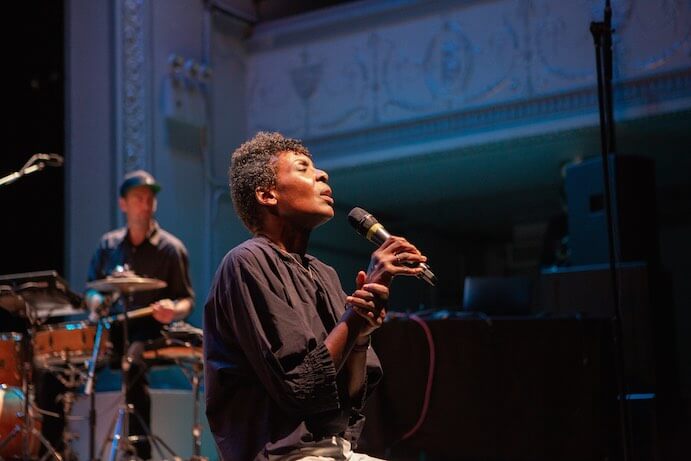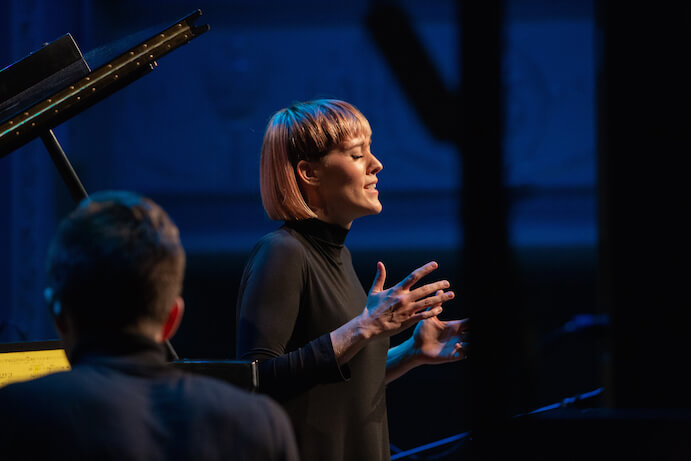Each year, the Resonant Bodies festival gathers for three nights of immersive soundscapes, daring vocals, and imaginative performers. Now in its sixth year, Founder and Director Lucy Dhegrae’s festival has become something of a New York City mainstay, and the full house at Roulette on September 11 proved just that. The structure of Resonant Bodies is simple: three evenings, each with three artists who present 45-minute solo sets. The artists can represent a wide range of disciplines and backgrounds, and with no restrictions on subject, style, or format, they are linked by only one quality: the voice. This year’s festival opened with Paul Pinto, Helga Davis, and Lucy Dhegrae, each of whom creatively explored the way our bodies make sound.
When Paul Pinto took the stage to introduce his program, he began by telling the audience that a woman he knows loves two things: shoulder rubs and movie plot summaries. So as he relayed the full plots of one movie and two epic poems, he asked the audience to turn to the person in front of them and give them a shoulder massage. The feeling of being slightly uncomfortable in a room full of strangers did not go unnoticed, but as strange looks took over the crowd, there was also a sense of camaraderie in this shared experience before the performance had even begun.
Pinto’s set was drawn from his “15 Photos,” a song cycle inspired by medieval epics, aging, love, and death. After the introduction, the lights went out and a drone enveloped the room. Pinto became all of the characters, each with their own sound, which seemed to mine the depths of every vocalism Pinto was capable of producing. From plainly spoken chant-like text to low grunts and guttural growls, a belty pop-tinged melody, and high-pitched screeches, “15 Photos” utilizes every aspect of vocal production. The variety of lighting and stage effects—projected shadows in “On Boxing” and the careful manipulation of a rope in “Reverie”—made the song cycle feel more of a dramatic musical work. Yet the full narrative was hard to pinpoint without hearing the entire work (only 10 of the songs were performed).

Paul Pinto performs at Resonant Bodies 2018–Photo by Gretchen Robinette
The highlight of “15 Photos” came midway through the set. A spotlight focused on the edge of the stage and the drone re-entered, almost inaudibly. Pinto, crouched in the light, whispered the word “hands” over and over as he meticulously moved his own hands in the soft glow. As the drone gained strength and changed pitch to create an eerie chord progression, Pinto too increased his volume, now crying “my hands.” The words, at first trepidatious, became pained and strongly enunciated, as if he was calling out repeatedly but receiving no answer. After the intensity reached a climax, or perhaps when Pinto felt like his cries may never be answered, everything gradually faded, just as it had begun. The simplicity of this darkly moving moment held the audience’s attention so completely that I felt we had all been brought to a particularly vulnerable state only to be left there, far from any sense of relief.
After a brief pause, Helga Davis entered, casually milled about, and then began to sing the Star Spangled Banner into the microphone. Yet this national anthem, complete with operatic melismas, gospel belt, jazz scatting, and the highest possible screeches, was like no other. In the span of one phrase, Davis manipulated her voice to reference multiple styles, exhibiting unbelievable control of her instrument. The searing satire came through most clearly as Davis summoned a Star Spangled Banner performance you may know from your high school football field—painstakingly searching for a note, repeating the same word over and over on slightly different pitches as if she couldn’t quite find the key. When this pluralistic and off-kilter national anthem was about to come to its “big finish,” Davis turned to the audience and quietly asked for us to help, almost as if the idea had just come to her. The full room followed Davis’ lead and gently sang the final words of the Star Spangled Banner, living in the same potentially uncomfortable space that had been set up earlier in the evening.

Helga Davis performs at Resonant Bodies 2018–Photo by Gretchen Robinette
Davis’ set, “An action, taken.” explored spoken word, instrumental interludes and catchy melodies, with flexing by dancer Reggie “Regg Roc” Gray, and film by Derrick Belcham. Davis alternated between reciting stories over an instrumental undercurrent (provided by pianist Tariq Al-Sabir and drummer Sean Dixon) and singing her own tunes. At one point, Davis asked everyone to look into the eyes of someone sitting nearby and sing with her: “Wanna be your heart and beat for you, wanna be your eyes and see for you…”. The moment was both uncomfortable and powerful, as Davis suspended the audience in this oddly beautiful world of her own design.
Lucy Dhegrae was the final performer to take the stage, performing Christopher Trapani’s “Waterlines,” with the Talea Ensemble. Trapani’s short song cycle draws inspiration from songs written around the 1927 Mississippi River flood. Occasionally, Trapani kept some of the original folk elements, but more often he took them apart, breaking down the structure into new melodies, fragments of the blues, and expansions of these old recordings. Dhegrae’s voice, the highlight of the work, exhibited virtuosity and control, naturally shifting from gentle folk to belted intensity. At times, though, the complexity of the orchestration and intricately layered textures unfortunately masked Dhegrae’s vocal line.

Lucy Dhegrae performs at Resonant Bodies 2018–Photo by Gretchen Robinette
Whether through woofs, coos, and squeaks, operatic melismas, scatting, or reconstructed folk melodies, Pinto, Davis, and Dhegrae showcased the malleability of the human voice as an expressive instrument. If the audience had been anticipating a simple sit-back-and-relax type of performance, they were surely mistaken, for at each and every turn they were called upon to participate in the art-making themselves. For as Davis simply stated, the collective experience was a necessary component of the evening:
“What is the sound of a resonating body?
you are part of the answer…”





















